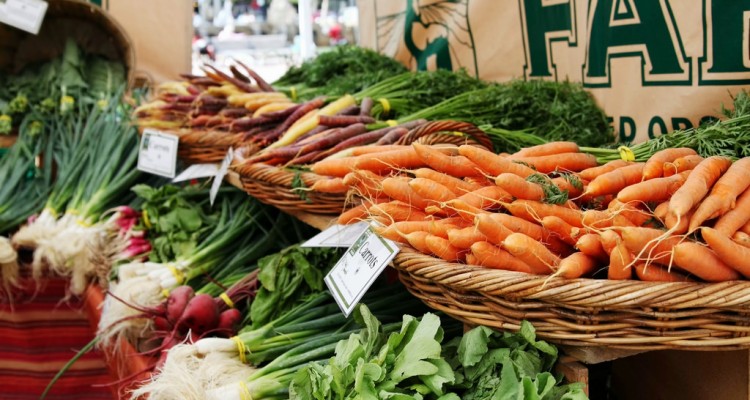You shouldn’t have to choose between your savings and eating healthy and with a little bit of planning, you don’t need to.
We may say that eating healthy is a priority, but most of us don’t invest in nutrition. One reason for this is the prevailing notion that healthy equals expensive. It’s true that fresh produce can be pricier than fulling up your cabinets with junk food, but it doesn’t have to be. And if you look at the medical costs associated with a lifetime of poor food choices, splurging on some spinach and blueberries suddenly doesn’t seem so bad.
With a little bit of foresight and a commitment to making conscious choices at the grocery store, you can start eating healthy without breaking the bank.
Here are ten tips to help you on your food journey, so you can eat well–without expanding your grocery budget:
Related: Cooking from Scratch: Breaking the Prepackaged Habit
1. Get creative with your pantry
Take stock of what you have in your kitchen cabinets and the refrigerator and find (or make your own) new recipes to incorporate what’s already there into your meals. Don’t forget to check your inventory before you head to the grocery store.
2. Stay in
For many, eating out sucks up a huge part of their food budget. If you cut down on going out for meals, you’ll not only save financially, but you’ll also be saving some calories. Research has shown that we consume 200 calories more a day when we eat out, not to mention more sodium and saturated fat. Don’t want to skip date night? Try switching to homemade lunches. Which brings us to:
3. Prepare your meals in advance
Make Sundays or Wednesdays your prep days, and consider cooking multiple portions for the week ahead. Learn to use a slow cooker and make chili. My grandmother and mother taught me you can pretty much cook a unicorn in that bad boy and it will taste delicious.
4. Savor your meals
The food you eat should bring you pleasure, otherwise eating healthy will become a chore and won’t stick. Find what you love. Personally, I love power shakes. Try mixing blueberries, fruits, greens, nut butter, protein powder, and chia seeds for a tasty, easy, on-the-go meal filled with quality nutrition.
5. Buy in bulk
Any grains, nuts, spices or legumes can be stored in mason jars or airtight containers.Buying dried beans by the pound rather than by the can will add up to savings. Additionally, you can split the cost and the goods with a group of friends. Frozen fruit and berries are an especially good buy, since most of them were picked and frozen at the height of their ripeness. During the cold months, rather than reaching for a sour and pricey strawberry, reach into your freezer for a sweeter treat.
6. Check out the expiration date
Produce that is soon to expire is often marked down big time. Just be sure to use it immediately or freeze it for later. The last thing you want to do is create food waste: bad for the planet and your wallet.
7. Find value in imperfection
Call me crazy, but a small dent, scratch, or tear doesn’t ruin a can of tomatoes for me. If the packaging is still intact, you’re good to go and can probably finagle a discount. One thing to look out for is cans that are bulging outwards. The likely culprit is gas that has been created by bacteria that managed its way into the can before it was sealed.
8. Stop by the farmer’s market
Since moving to South Florida, I have learned so much about this. Food in season tastes extra delicious, and supporting local farmers is a plus. In order to save money at the market, as with buying in bulk at the supermarket, split the cost of a flat of berries with a friend. You can also ask the farmers if they have any slightly bruised or imperfect fruits and vegetables they’d like to offload. Another trick is to shop at the end of the day. The selection won’t be as inspirng, but the prices might be.
9. Choosing organic doesn’t mean eating healthy
Look closely at the food labels on your organic products. Processed, sugary products that are technically “organic” can end up being twice as expensive as conventional foods, and just as bad for you. How different are those sugar-filled cereals that go for upwards of $5 a box?
10. Treat yourself
The healthiest and most delicious options may not be on sale. But if you’ve managed to save on a five pound bag of brown rice, bargained for some imperfect tomatoes at the market and cooked up a chili with some beans past their expiration, go ahead and buy the expensive fragrant cherries. Eating healthy should make you feel good, not deprived.
Once you find which of these ideas work for you, you’ll not only save some cash but you’ll also be saving yourself from a lot of troubles down the line.
Shop better with these 3 strategies:
- Buy minimally processed foods
- Shop on a full stomach. This will keep you focused on what you actually need so you can avoid impulse buys.
- Shop the perimeter–this means shopping the outer aisles of the grocery store (produce, dairy, meats) avoiding the junk-filled aisles in the middle.
Hungry to get started? Check out these healthy recipes:
Salmon Cakes With Cucumber Dill Sauce
7 DIY Protein Bars That Blow Your Quest Bar Out Of The Water

